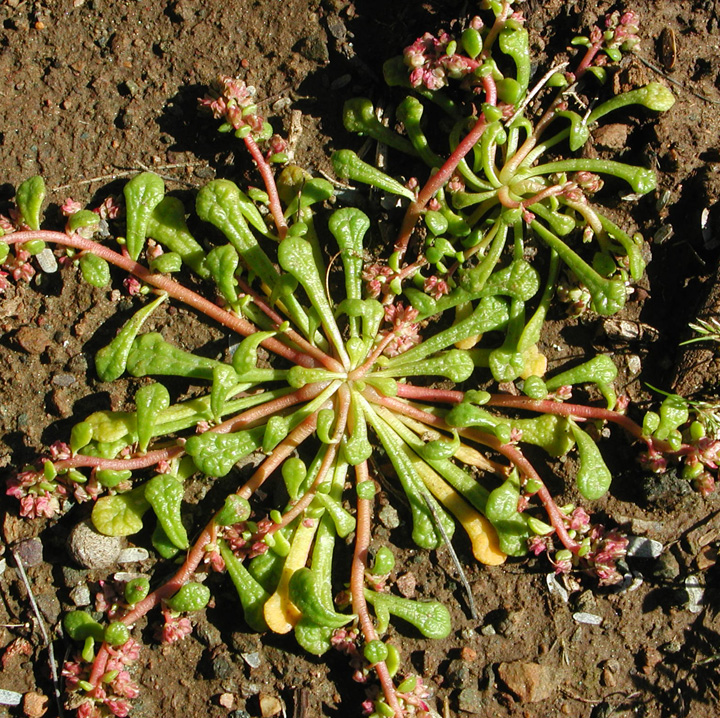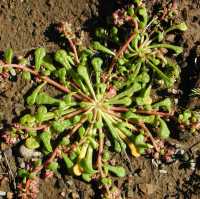Herbs, annual or perennial, succulent, glabrous, with caudices, not rhizomatous or stoloniferous. Roots fleshy and/or fibrous, or taproots. Stems decumbent to erect, simple or branched; nodes glabrous. Leaves basal and/or cauline, glabrous, not articulate at base, somewhat to markedly clasping, attachment points linear; basal leaves in rosettes; cauline leaves alternate (usually absent in C. umbellata and C. tweedyi). Inflorescences axillary, umbellate, paniculate, racemose, or cymose, sometimes scorpioid and/or secund, loose to dense, 1-many-flowered, leafy and/or bracteate; bracts (1-)2 subtending each flower, markedly unequal. Flowers pedicellate to subsessile; sepals persistent, distinct, not keeled or angled, often unequal, herbaceous to scarious, glabrous; petals 2-9(-12), distinct; stamens 1-23; ovules 1-many; style present or absent; stigmas 2 or 3. Capsules 2-3-valved, dehiscence loculicidal from apex, valves not deciduous, (except C. tweedyi, which has circumscissile deshiscence and 3-4 valves splitting from base), margins not reflexed after dehiscence, margins not markedly involute. Seeds 1-40, dark brownish red, dull gray, or black, usually elliptic to orbiculate, sometimes orbiculate-reniform, dull or shiny, smooth or sculptured, sometimes hairy, strophiolate in C. maritima and C. tweedyi. x = 22, 23.
Publications by R. C. Carolin (1987) and M. A. Hershkovitz (1991, 1991b) have required the addition to the North American flora of the genus Cistanthe, which originally was erected to accommodate some Chilean species that were segregated from Calandrinia. Recent investigations indicate that a considerably broader range of species belongs in the genus, including two North American species formerly placed in Calandrinia, all the species formerly included in Calyptridium, and one species previously classified in Lewisia. While the current recognition of Cistanthe originally rested on the cladistic work of Carolin and the studies of leaf morphology by Hershkovitz, who documented nine traits of leaf morphology distinguishing Cistanthe, more recent molecular studies by M. A. Hershkovitz and E. A. Zimmer (2000) have provided general support for it. The inclusion of C. tweedyi appears to be somewhat equivocal and it might best be treated as a distinct genus.
PLANT: Annual, biennial, or perennial herbs.
STEMS: simple or branched, spreading to ascending or erect.
LEAVES: in basal rosette or basal and cauline, linear to spatulate, entire, generally succulent.
INFLORESCENCE: a raceme or panicle of umbellate clusters, generally one-sided.
FLOWERS: few to many, pedicellate or sessile, each subtended by two unequal bracts; petals white to pink; sepals ovate, scarious or scarious-margined; petals 2-12; stamens 1-23; styles present or absent; stigmas 2-3, sessile or stalked.
CAPSULE: with 2-3 valves.
SEEDS: one to many, elliptic to round, black, smooth to sculptured.
NOTES: Ca. 35 spp. distributed from N. to S. Amer. Spach (1836) described the genus Cistanthe to accommodate several Chilean species that he segregated from Calandrinia. Recent cladistic investigations (Hershkovitz 1991) indicate that many other species also belong in Cistanthe. These include the Arizona species formerly recognized as Calandrinia ambigua, Calyptridium monandrum, and Calyptridium parryi.
REFERENCES: Bair, Allison, Marissa Howe, Daniela Roth, Robin Taylor, Tina Ayers, and Robert W. Kiger. 2006. Vascular Plants of Arizona: Portulacaceae. CANOTIA 2(1): 1-22.













